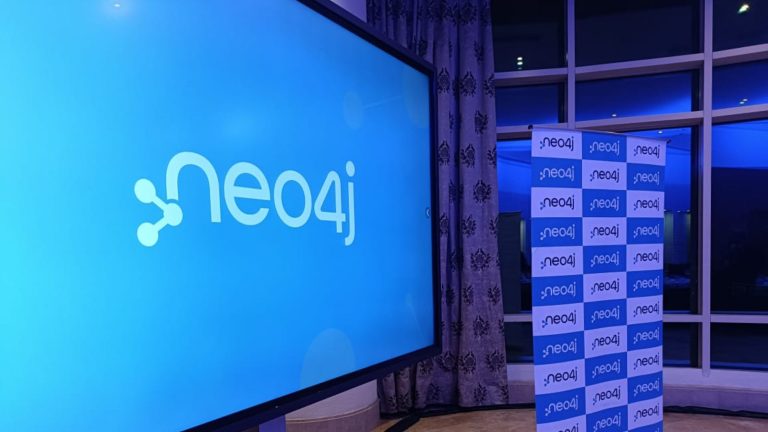|
Listen to this story
|
Currently, relational databases dominate with a 90% market share. However, when it comes to a graph database, there is little or no understanding of how it works. Some of the prominent relational databases include Microsoft SQL Server, Oracle Database, MySQL and IBM DB2.
“Lack of understanding and awareness of graphs is their biggest competitor,” Dr. Jesus Barrasa, head of solutions architecture at Neo4j, in an interview with AIM, at their Annual Graph Summit in Mumbai.
He said that many solutions are built on relational databases due to a lack of awareness of specialised graph stores. the lack of understanding and awareness of graphs as their biggest competitor. He added that many solutions are built on relational databases due to a lack of awareness of specialised graph stores.
Dr Jesus Barassa at graphsummit
Adding on to what Barrasa said, said Dr Jim Webber, chief data scientist at Neo4j told AIM that graph databases can offer improved efficiency for many business information systems, but awareness and openness to new tools are crucial for exploring better solutions.
Dr Jim Webber at graphsummit
Overall, they believe in the adoption and coexistence of relational and graph databases rather than direct competition.
Graph Database Vs Relational Database
Graph databases store relationships as data, allowing real-time addition of nodes and relationships, while relational databases focus on relationships between columns and allow adding tables and columns on the go. Graph databases excel in executing complex queries, outperforming relational databases that rely on slower joins between tables.
However, amid the to and fro between relational and graph databases, Neo4j disrupted the ecosystem with a graph database of the same name along with its declarative query language called Cypher, borrowing concepts from SPARQL.
Unmasking the Power of Graph Technology
Graph technology is being widely adopted across diverse industries for more efficient data analysis and decision-making. Major sectors utilising graph technology include social networking, telecommunications, banking, fraud detection, transaction processing, compliance and regulation, supply chain and logistics, and medical research.
Companies like Cisco, British Telecom, Airbus, Novartis, and Boston Scientific are employing graph technology to enhance their operations.
Infosys, an IT giant, uses a knowledge graph to consolidate information about their employees’ skills and career paths, enabling them to answer questions about career progression, skill utilisation, and project assignments.
NASA utilises graph technology in their content management systems to perform semantic searches, explore related topics, and offer personalized recommendations based on the content. They combine natural language processing (NLP) techniques with taxonomy and domain knowledge to extract entities and annotate documents.
Telecommunications companies like British Telecom use graph representations of their data to handle complex inquiries about network topology, identify critical equipment and analyse root causes of structural issues.
Government agencies and police departments also employ graph technology to uncover illicit activities, establish connections, identify communities engaged in criminal behaviour, and detect potential risks such as radicalisation or terrorist networks. One of its examples is when it was used in high-profile investigations like the Panama Papers, where the International Consortium of Investigative Journalists (ICIJ) utilized Neo4j to visualise connections between individuals and expose instances of financial wrongdoing, leading to the resignation of public figures in multiple countries.
Besides Neo4j Graph Database, other graph databases include Amazon Neptune, ArangoDB, DataStax, OrientDB, and Stardog among others. The graph database market is expected to grow by 22.5% to $5.1 billion by 2028.
Read more: Meet the Undisputed King of Real-Time in Serverless Databases
Born in India
Neo4j has a long-standing relationship with India. It came into existence in 2007 when Emil Eifrem, the visionary founder and CEO of Neo4j, collaborated with an intern from IIT Bombay during a flight to Bombay, crafting the first piece of code.
Now, the company looks to contribute more to India’s ever-evolving AI/ML ecosystem, Webber told AIM that they are planning to have product specialists and research teams in India to leverage academic research and collaborate with institutions like IIT Bombay.
“The Indian startup community is vast, hungry, and ever-growing and we see it as a major area of investment,” Webber commented. He added that India has a wide range of needs, from space programs to critical issues like food supply, where graph databases can play a role.
India is seen as a promising market with immense potential to become a tech leader in the world. Its large population and technological talent make it a prime location for investment and growth. It has a diverse range of needs and a growing tech economy. In the past, the focus was on serving Western markets, but now there is a shift towards addressing domestic market opportunities.
Echoing similar feelings, Barrasa said that their last year’s India experience in Bangalore with a knowledgeable and skilled audience of 500 people surpassed introductory sessions in Singapore and Australia in terms of expertise and advanced questions.
What’s next?
“We expect GQL (Graph Query Language) to be standardised by the end of the year,” said This is important because it will allow developers to build portable applications that are not locked into a particular vendor.
Neo4j is already implementing GraphQL features, so it will be aligned with the standard by the time it is finalised.
“Unlike other technologies that were absorbed into SQL, GQL recognises the distinctiveness and value of graphs, warranting its own query language. We have been working on GQL for years, drawing influence from Cypher Query Language,” concluded Webber.
Read more: What’s Behind the Surge in Vector Database Investments?



















































































